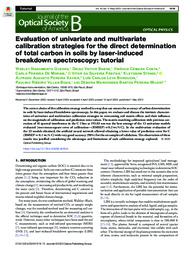Evaluation of univariate and multivariate calibration strategies for the direct determination of total carbon in soils by laser-induced breakdown spectroscopy: tutorial.
Evaluation of univariate and multivariate calibration strategies for the direct determination of total carbon in soils by laser-induced breakdown spectroscopy: tutorial.
Author(s): GUEDES, W. N.; BABOS, D. V.; COSTA, V. C.; MORAIS, C. P de; FREITAS, V. S.; STENIO, K.; XAVIER, A. A. P.; BORDUCHI, L. C. L.; VILLAS-BOAS, P. R.; MILORI, D. M. B. P.
Summary: The correct choice of the calibration strategy method is a step that can ensure the accuracy of carbon determination in soils by laser-induced breakdown spectroscopy. In this paper, we evaluate and discuss the intrinsic characteristics of univariate and multivariate calibration strategies in overcoming soil matrix effects and their influence on the magnitude of calibration and prediction error values. The matrix-matching calibration with previous correction of Al spectral interference in the C I line at 193.03 nm was the best strategy of the 13 univariate models evaluated [root-mean-square error of calibration?(RMSEP) = 0.2 wt.% C]. In the multivariate evaluation of the 22 models obtained, the artificial neural network allowed obtaining a lower value of prediction error for C (RMSEP = 0.1 wt.% C) with very good accuracy (98%) for the set samples of validation. The observation of these results was justified considering the advantages and limitations of each calibration strategy explored.
Publication year: 2023
Types of publication: Journal article
Unit: Embrapa Instrumentation
Observation
Some of Embrapa's publications are published as ePub files. To read them, use or download one of the following free software options to your computer or mobile device. Android: Google Play Books; IOS: iBooks; Windows and Linux: Calibre.
Access other publications
Access the Agricultural Research Database (BDPA) to consult Embrapa's full library collection and records.
Visit Embrapa Bookstore to purchase books and other publications sold by Embrapa.

